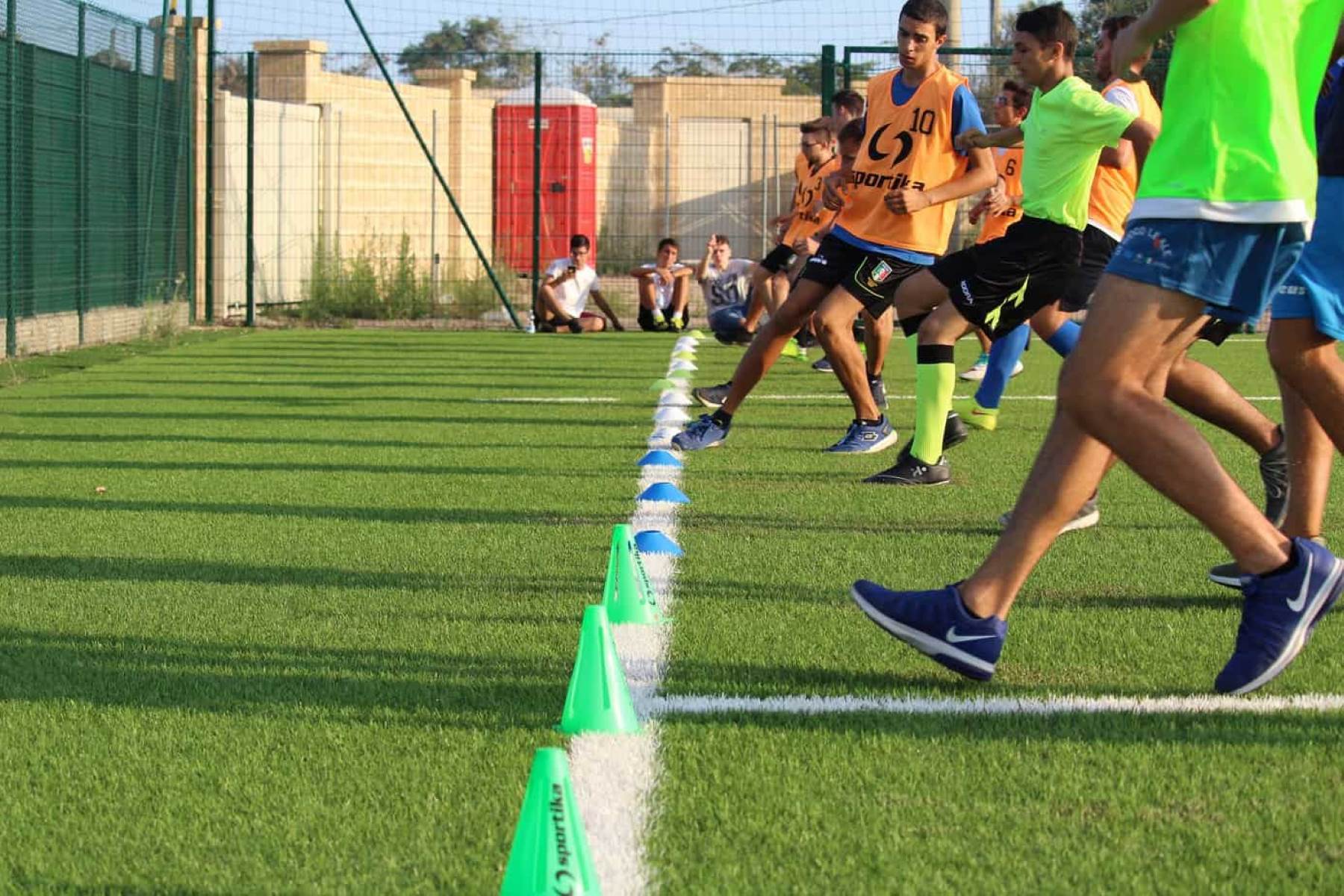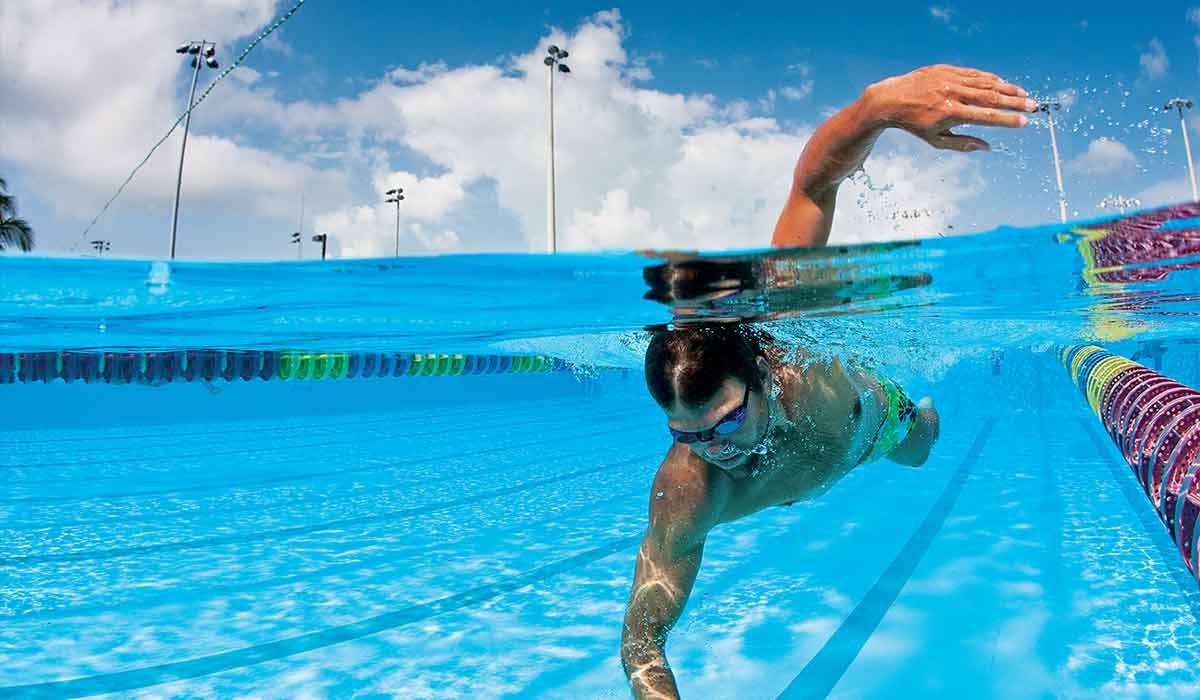Home>Misc>Featured>How Does The Intermittent Recovery Test Differ From The Intermittent Endurance Test?


Featured
How Does The Intermittent Recovery Test Differ From The Intermittent Endurance Test?
Modified: January 2, 2024
Discover the key differences between the Intermittent Recovery Test and the Intermittent Endurance Test in this featured article. Enhance your understanding of these fitness assessments.
Introduction
In the world of sports science and performance testing, there are various methodologies used to assess an athlete’s fitness level and capacity for endurance. Two commonly utilized tests are the Intermittent Recovery Test (IRT) and the Intermittent Endurance Test (IET). While both tests involve intermittent exercise, they have distinct differences in terms of purpose, protocol, and physiological demands.
The Intermittent Recovery Test is designed to evaluate an athlete’s ability to recover from intense bouts of exercise. It aims to assess the efficiency of the athlete’s cardiovascular system and their capacity to regenerate energy stores during periods of active recovery. On the other hand, the Intermittent Endurance Test focuses on an athlete’s endurance capabilities during repeated bouts of high-intensity exercise.
Understanding the differences between these two tests is crucial for professionals in the field of sports physiology, strength and conditioning, and performance testing. This knowledge enables them to tailor training programs, develop appropriate recovery strategies, and monitor an athlete’s progress accurately.
Throughout this article, we will delve into the key differences between the Intermittent Recovery Test and the Intermittent Endurance Test, explore the protocols used for each test, analyze the physiological demands they impose on athletes, and discuss performance measures and practical applications.
Now, let’s dive further into the intricacies of these tests and explore how they differ in terms of purpose and application.
Key Differences between the Intermittent Recovery Test and the Intermittent Endurance Test
The Intermittent Recovery Test (IRT) and the Intermittent Endurance Test (IET) may both involve intermittent exercise, but they serve different purposes and have distinct characteristics. Here are the key differences between these two tests:
- Purpose: The IRT is primarily used to assess an athlete’s ability to recover from intense bouts of exercise. It focuses on the cardiovascular system’s efficiency in replenishing oxygen stores, removing metabolic waste, and reducing heart rate during periods of active recovery. On the other hand, the IET aims to evaluate an athlete’s endurance capacity during repeated bouts of high-intensity exercise. It tests an athlete’s ability to sustain their performance over an extended period of time.
- Protocol: The protocols for the IRT and IET differ significantly. In the IRT, athletes perform repeated high-intensity intervals followed by active recovery periods. The duration and intensity of the intervals are predetermined, and the test concludes when the athlete cannot maintain the required speed or cannot recover within the allocated recovery time. In contrast, the IET involves continuous exercise at a high intensity for a specific duration, often measured in minutes. The test continues until the athlete can no longer maintain the required speed or until they reach the predetermined time limit.
- Exercise Intensity: Both tests involve high-intensity exercise, but the intensity patterns differ. In the IRT, the intensity varies between maximal effort during the intervals and active recovery during the recovery periods. This fluctuation allows for the assessment of an athlete’s ability to recover and regenerate energy stores. In the IET, the exercise intensity is consistently high throughout the test, challenging an athlete’s endurance and stamina.
- Physiological Demands: The physiological demands placed on athletes during the IRT and IET vary. The IRT primarily stresses the cardiovascular system, putting more emphasis on cardiac output, oxygen uptake, and lactate clearance. It also targets the athlete’s ability to transition from high-intensity exercise to active recovery efficiently. In contrast, the IET places greater demands on the aerobic energy system, muscular endurance, and the athlete’s ability to maintain a high level of performance during prolonged periods of exercise.
- Performance Measures: The performance measures used in the IRT and IET differ based on the test objectives. In the IRT, the common performance measures include the total distance covered, heart rate recovery during the active recovery periods, and the ability to maintain the required speed throughout the test. In the IET, performance measures typically include the total time or distance achieved before reaching exhaustion, average speed or power output over the test duration, and the ability to maintain the required intensity.
Understanding these key differences between the Intermittent Recovery Test and the Intermittent Endurance Test allows professionals and coaches to select the appropriate test for their athletes based on individual goals, sport-specific demands, and training objectives.
Test Protocol for the Intermittent Recovery Test
The test protocol for the Intermittent Recovery Test (IRT) consists of a structured sequence of high-intensity exercise intervals followed by active recovery periods. This protocol aims to evaluate an athlete’s ability to recover efficiently from intense exercise bouts. Here are the key components of the IRT test protocol:
- Warm-up: Prior to the test, athletes should undergo a thorough warm-up to prepare their muscles and cardiovascular system for the upcoming high-intensity exercise. The warm-up should include dynamic stretches, mobility exercises, and a gradual increase in intensity to elevate heart rate and body temperature.
- Exercise Intervals: The IRT involves performing repeated high-intensity exercise intervals. The duration and intensity of these intervals are predetermined based on the specific test protocol being used. Typically, the intervals are performed at near-maximal effort to elicit a significant physiological response. The athlete should give their best effort during each interval to accurately assess their recovery capacity.
- Active Recovery: After each exercise interval, a set period of active recovery is provided. This active recovery phase allows the athlete to lower their heart rate, catch their breath, and partially regenerate energy stores. The duration and intensity of the active recovery periods are also predetermined and can vary depending on the specific test protocol being used.
- Incremental Increase: In some IRT protocols, the intensity or duration of the exercise intervals may gradually increase as the test progresses. This incremental increase places additional stress on the athlete’s cardiovascular system and challenges their ability to recover efficiently. It allows for a more comprehensive assessment of the athlete’s recovery capacity over a range of exercise intensities.
- Test Termination: The IRT test continues until the athlete reaches their limit and can no longer maintain the required speed or cannot recover within the allocated active recovery time. The test termination criteria should be clearly defined before the test begins to ensure accurate and consistent results.
- Cool-down: Following the completion of the IRT, athletes should engage in a proper cool-down routine to gradually decrease their heart rate, stretch their muscles, and aid in the removal of metabolic waste products. This helps to promote recovery and reduce the risk of post-exercise soreness or injury.
It is essential to adhere to the specific test protocol for the IRT to ensure consistency and accurate assessment of an athlete’s recovery capacity. Coaches and sports professionals should also consider the individual characteristics and fitness levels of the athletes when implementing the test protocol, as it may need to be modified accordingly.
Test Protocol for the Intermittent Endurance Test
The Intermittent Endurance Test (IET) is designed to measure an athlete’s endurance capabilities during repeated bouts of high-intensity exercise. The test protocol for the IET involves continuous exercise at a high intensity for a specific duration. Here are the key components of the IET test protocol:
- Warm-up: Prior to the test, athletes should engage in a comprehensive warm-up routine. This includes dynamic stretches, mobility exercises, and light cardiovascular activity to prepare the muscles, joints, and cardiovascular system for the upcoming high-intensity exercise.
- Exercise Intensity: The IET involves performing continuous exercise at a high intensity throughout the test duration. The intensity should be set at a level that challenges the athlete’s aerobic capacity and endurance. The specific exercise mode can vary depending on the sport or activity being tested, such as running, cycling, or swimming.
- Test Duration: The duration of the IET is predetermined based on the specific test protocol being used and the goals of the assessment. Typically, the test duration ranges from a few minutes to several hours, depending on the sport and the fitness level of the athlete. The aim is to assess the athlete’s ability to maintain their performance at a high intensity over an extended period of time.
- Incremental Increase: In some IET protocols, the exercise intensity or resistance may gradually increase as the test progresses. This incremental increase challenges the athlete’s endurance capacity and allows for a more comprehensive assessment of their stamina and ability to sustain high-intensity efforts.
- Monitoring: Throughout the test, it is essential to monitor various parameters such as heart rate, perceived exertion, power output, or pace to track the athlete’s performance and determine their capabilities. This data can provide valuable insights into the athlete’s endurance capabilities and can be used to guide training and performance enhancement strategies.
- Test Termination: The IET continues until the athlete reaches a point of exhaustion or can no longer maintain the required intensity or pace. The test termination criteria should be clearly defined before starting the test to ensure consistency and accurate assessment of the athlete’s endurance capacity.
After completing the IET, athletes should engage in a proper cool-down routine, including light aerobic exercise and stretching, to aid in recovery and reduce the risk of post-exercise soreness or injury.
It is important to note that the specific test protocol for the IET may vary depending on the sport, exercise modality, and individual characteristics of the athlete. Coaches and sports professionals should consider these factors when implementing the IET to ensure accurate assessment of an athlete’s endurance capabilities.
Comparison of Test Parameters
When comparing the Intermittent Recovery Test (IRT) and the Intermittent Endurance Test (IET), various test parameters can shed light on the differences between the two assessments. By examining these parameters side by side, one can gain a deeper understanding of how the tests differ in terms of intensity, duration, and physiological demands. Here is a comparison of the key test parameters for the IRT and the IET:
- Intensity: The IRT involves intermittent exercise with varying intensities, which include high-intensity exercise intervals followed by active recovery periods. In contrast, the IET involves continuous exercise at a high intensity throughout the test duration. The IET places a consistent demand on the athlete’s aerobic capacity and requires sustained effort at a high intensity.
- Duration: The duration of the IRT is typically shorter compared to the IET. The IRT may last for a few minutes, whereas the IET can range from a few minutes to several hours, depending on the test protocol and the athlete’s fitness level. The longer duration of the IET allows for a more comprehensive assessment of an athlete’s endurance capacity.
- Recovery periods: In the IRT, active recovery periods follow high-intensity exercise intervals. These recovery periods provide an opportunity for the athlete to partially regenerate energy stores and reduce heart rate. Conversely, the IET does not incorporate designated recovery periods. Instead, the athlete must sustain a high level of performance throughout the entire test duration, challenging their endurance capacity.
- Physiological demands: The physiological demands placed on athletes during these tests differ. The IRT primarily stresses the cardiovascular system, with a focus on heart rate recovery, oxygen uptake, and lactate clearance. It also targets the athlete’s ability to transition from high-intensity exercise to active recovery efficiently. On the other hand, the IET places greater demands on the aerobic energy system, muscular endurance, and the athlete’s ability to maintain a high level of performance over an extended period of time.
- Performance measures: The performance measures used for the IRT and the IET vary. In the IRT, common performance measures include the total distance covered, heart rate recovery during the active recovery periods, and the ability to maintain the required speed throughout the test. In the IET, performance measures typically include the total time or distance achieved before reaching exhaustion, average speed or power output over the test duration, and the ability to maintain the required intensity.
By comparing these test parameters, one can appreciate the differences in intensity, duration, recovery periods, physiological demands, and performance measures between the IRT and the IET. These variances reflect the distinct objectives of the tests and highlight the specific capacities being tested, whether it be recovery ability or endurance capacity.
Physiological Demands of the Intermittent Recovery Test
The Intermittent Recovery Test (IRT) places specific physiological demands on athletes, focusing on their ability to recover efficiently from intense exercise bouts. Understanding these physiological demands is crucial for athletes, coaches, and sports professionals to tailor training programs and optimize performance. Here are the key physiological demands of the IRT:
- Cardiovascular System: The IRT places considerable stress on the cardiovascular system. During the high-intensity exercise intervals, there is increased demand for oxygen and nutrients by the working muscles. The cardiovascular system responds by increasing cardiac output, elevating heart rate, and redistributing blood flow to meet the metabolic needs of the exercising muscles.
- Oxygen Uptake: The IRT challenges an athlete’s oxygen uptake capacity. The high-intensity exercise intervals require a significant consumption of oxygen to support aerobic metabolism. Efficient oxygen uptake is crucial for delivering oxygen to the working muscles, allowing them to generate the required energy for the task at hand.
- Lactate Clearance: One of the physiological demands of the IRT is effective lactate clearance. During high-intensity exercise, the production of lactate exceeds the rate at which it can be removed from the muscles and bloodstream. The active recovery periods in the IRT provide an opportunity for the body to clear lactate, allowing for improved performance in subsequent exercise intervals.
- Energy System Utilization: The IRT predominantly relies on the anaerobic energy system, specifically the phosphocreatine system and the glycolytic system. The intense exercise intervals require the rapid breakdown of phosphocreatine and the subsequent utilization of stored glycogen for energy production. The active recovery periods allow for regeneration of phosphocreatine and clearance of accumulated byproducts.
- Recovery Capacity: The IRT evaluates an athlete’s ability to recover efficiently between exercise intervals. This includes the ability to lower heart rate, restore oxygen levels, and remove accumulated metabolic byproducts. The active recovery periods challenge the athlete’s recovery capacity and help assess their ability to regenerate energy stores during periods of active rest.
Understanding the physiological demands of the IRT can guide training strategies and aid in the development of targeted interventions to optimize an athlete’s recovery and performance. Coaches and sports professionals can focus on improving cardiovascular function, enhancing oxygen uptake capacity, promoting effective lactate clearance, and optimizing the athlete’s ability to recover during active rest periods.
Physiological Demands of the Intermittent Endurance Test
The Intermittent Endurance Test (IET) places specific physiological demands on athletes, challenging their endurance capabilities during repeated bouts of high-intensity exercise. Understanding these physiological demands is vital for athletes, coaches, and sports professionals to develop effective training programs and optimize performance. Here are the key physiological demands of the IET:
- Aerobic Energy System: The IET primarily stresses the aerobic energy system, which relies on oxygen to produce energy for sustained exercise. This test requires athletes to maintain a high intensity throughout the entire duration, placing a significant demand on their aerobic capacity. The efficient utilization of oxygen by the muscles is crucial for sustaining performance and delaying fatigue.
- Muscular Endurance: The IET challenges an athlete’s muscular endurance, as they must repeatedly perform high-intensity exercise for an extended period of time. This places continuous stress on the muscles, requiring them to generate force and sustain contractions over multiple intervals. Improved muscular endurance allows athletes to maintain power output and performance over the course of the test.
- Oxygen Uptake: The IET places a significant demand on oxygen uptake. The sustained high-intensity exercise requires a continuous supply of oxygen to the working muscles to support aerobic metabolism. Efficient oxygen uptake and delivery are critical for meeting the energy demands of the muscles and sustaining performance throughout the test.
- Metabolic Waste Accumulation: During the IET, metabolic waste products accumulate in the muscles due to the sustained high-intensity effort. These waste products, such as lactic acid, can impair muscular function and contribute to fatigue. The ability to manage and clear these waste products during short recovery periods is crucial for maintaining performance during subsequent intervals.
- Thermoregulation: The IET places a demand on the body’s thermoregulatory system as the prolonged, high-intensity exercise generates heat. Effective thermoregulation is important for maintaining core body temperature within a safe range, ensuring optimal physiological function and minimizing the risk of heat-related issues.
Understanding the physiological demands of the IET can guide training strategies and aid in the development of targeted interventions to improve an athlete’s endurance capacity. Coaches and sports professionals can focus on enhancing aerobic capacity, improving oxygen uptake and delivery, optimizing muscular endurance, and implementing strategies to manage and clear metabolic waste products. By addressing these physiological demands, athletes can enhance their performance and prolong their ability to sustain high-intensity efforts during prolonged exercise bouts.
Performance Measures and Interpretation
Performance measures play a vital role in assessing an athlete’s performance and interpreting the results of the Intermittent Recovery Test (IRT) and the Intermittent Endurance Test (IET). These measures provide valuable insights into an athlete’s fitness level, endurance capacity, and recovery abilities. Here are some common performance measures used for these tests and how they can be interpreted:
- Total Distance Covered: Tracking the total distance covered during the IRT and the IET provides an indication of an athlete’s overall endurance capacity. A greater distance covered generally indicates better endurance performance.
- Heart Rate Recovery: Heart rate recovery refers to how quickly an athlete’s heart rate returns to resting levels following exercise. In the IRT, a faster heart rate recovery during the active recovery period indicates a more efficient cardiovascular system and better recovery capacity. In the IET, heart rate recovery between exercise bouts can reflect an athlete’s ability to recover and maintain a high intensity throughout the test.
- Average Speed or Power Output: Average speed or power output can be used to assess an athlete’s overall performance during the IRT and the IET. Higher average speeds or power outputs generally indicate better endurance capacity and fitness levels.
- Time or Distance to Exhaustion: The time or distance an athlete can sustain their effort before reaching exhaustion is a crucial performance measure for both tests. Longer time or greater distances achieved indicate a higher level of endurance and a better ability to sustain intensity over time.
- Perceived Exertion: Perceived exertion ratings, such as the Borg Rating of Perceived Exertion (RPE) scale, provide insights into an athlete’s subjective experience of effort during the tests. Higher perceived exertion values may indicate greater intensity and effort put forth during the exercise intervals. Monitoring and comparing perceived exertion across intervals can help gauge an athlete’s ability to sustain effort and manage fatigue.
The interpretation of these performance measures should consider various factors, including the athlete’s training status, sport-specific demands, and individual characteristics. It is essential to establish baseline measurements for each athlete to track progress over time and assess improvements in endurance capacity and recovery abilities.
Furthermore, performance measures should be interpreted in conjunction with other physiological indicators and the athlete’s overall training and competition goals. Coaches and sports professionals can utilize these measures to identify strengths and weaknesses, tailor training programs, and implement targeted strategies to enhance an athlete’s endurance and recovery performance.
Practical Applications and Considerations
The Intermittent Recovery Test (IRT) and the Intermittent Endurance Test (IET) have practical applications in various fields of sports science and performance training. Understanding these applications and considering certain factors can help professionals make informed decisions and maximize the benefits of these tests. Here are some practical applications and considerations:
- Training Program Design: The results from the IRT and IET can guide the design and implementation of training programs. By assessing an athlete’s recovery capacity and endurance capabilities, coaches can tailor workouts to target specific areas for improvement. For example, if an athlete’s recovery capacity is lower, training programs can focus on enhancing cardiovascular fitness and improving the efficiency of energy regeneration during recovery periods. Conversely, if an athlete’s endurance capacity is a limiting factor, training programs can prioritize building aerobic capacity and muscular endurance.
- Individualized Approach: It is essential to consider the individual characteristics of athletes when using the IRT and IET. Factors such as training history, fitness level, age, and injury history can influence an athlete’s performance and recovery. Assessments should be customized based on these factors to provide a more accurate and effective evaluation of an athlete’s abilities and potential limitations.
- Sport-Specific Demands: Different sports have unique characteristics and demands, requiring specific adaptations in training. Coaches and professionals should consider the sport-specific demands when interpreting the results of the IRT and IET. For example, team sports involving intermittent bursts of high-intensity efforts may prioritize the athlete’s ability to recover quickly between actions, making the IRT particularly beneficial. In contrast, endurance-based individual sports such as long-distance running may focus more on the IET to assess sustained high-intensity efforts over an extended period.
- Periodization and Progression: The IRT and IET can assist in periodization and progression of training programs. By reassessing athletes at regular intervals, coaches can track progress and make informed decisions about adjusting training intensity, volume, and recovery strategies. This allows for the systematic and gradual development of an athlete’s endurance capacity and recovery abilities over time.
- Recovery Strategies: The results of the IRT can provide insights into an athlete’s recovery capacity and guide the development of effective recovery strategies. Coaches can implement tailored interventions to enhance an athlete’s recovery between intense exercise bouts, such as specific active recovery protocols, nutritional strategies, and regeneration techniques.
When applying the IRT and IET, it is crucial to consider the specific goals, objectives, and circumstances of the athletes and the sports they participate in. A multidimensional approach that integrates various assessment tools, such as physiological and biomechanical evaluations, can provide a more comprehensive understanding of an athlete’s performance and inform targeted interventions.
Additionally, ongoing education, staying updated with research, and utilizing the expertise of sports scientists and professionals in the field can help optimize the practical application of the IRT and IET to enhance athletic performance and maximize training outcomes.
Conclusion
The Intermittent Recovery Test (IRT) and the Intermittent Endurance Test (IET) are valuable tools in assessing an athlete’s fitness level, endurance capacity, and recovery abilities. While both tests involve intermittent exercise, they differ significantly in purpose, protocol, and physiological demands.
The IRT is designed to evaluate an athlete’s ability to recover from intense exercise bouts, focusing on the regeneration of energy stores and the efficiency of the cardiovascular system during active recovery periods. In contrast, the IET assesses an athlete’s endurance capabilities during sustained high-intensity exercise over an extended period.
Understanding the key differences between the IRT and IET allows professionals in the field of sports physiology, strength and conditioning, and performance testing to tailor training programs, develop appropriate recovery strategies, and monitor an athlete’s progress accurately.
By implementing the test protocols for the IRT and IET, practitioners can assess various performance measures that provide insights into an athlete’s recovery capacity, endurance capability, and physiological responses. These measures include total distance covered, heart rate recovery, average speed or power output, time or distance to exhaustion, and perceived exertion.
Practical applications of the IRT and IET include designing individualized training programs, considering sport-specific demands, implementing periodization and progression strategies, and developing targeted recovery interventions.
It is essential to consider the specific goals, objectives, and circumstances of athletes when applying the IRT and IET. Additionally, ongoing education, staying updated with research, and collaborating with sports scientists and professionals in the field contribute to optimizing the practical application of these tests.
By utilizing the IRT and IET effectively, coaches, trainers, and sports professionals can guide athletes towards improved endurance capacity, enhanced recovery abilities, and ultimately, better performance in their respective sports.









